The inevitable result of planting lots of trees on a property is that the garden becomes increasingly shady. When carried to an extreme (which I have) the exposure of the garden changes radically over time so that sun loving plants are plunged into darkness. Many shrubs are forgiving of the encroaching shade, but some are not, and perennials are less tolerant of the transition and often begin to fade and finally disappear with diminished sunlight.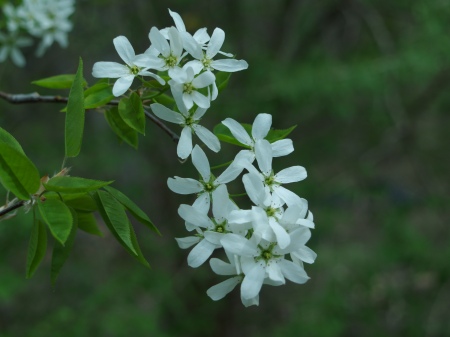
Twenty five years ago most of this property was open, with only tall swamp maples and tulip poplars along the southern border to obstruct the sun. The front garden was sunny in the morning and the rear garden in the afternoon. And, then I started to plant. A few dogwoods at first, then a beech, and redbuds. Then came a few Japanese maples, and magnolias, serviceberry, silver bells, fringetrees, and the list goes on. I didn’t stop planting until …. well, I haven’t stopped yet, and there’s barely an inch of the garden that’s not under the canopy of one tree or another.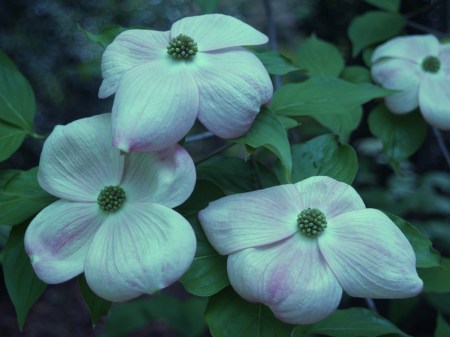
I’ve gotten caught up in collecting dogwoods, redbuds, magnolias, and Japanese maples so that I’m always on the lookout for just one more, regardless if there’s adequate space for it. Now is an appropriate time to suggest that this is not the proper way to go about designing a garden. I’ll concede that there are occasional problems with one thing or another being too close, but it’s my garden, and if I don’t want to be bothered with details, so be it. In fact, only a few evergreens and stray perennials have been lost, and trees that grow into one another are mostly not a problem. I prefer one tree blending into the other, without defined lines between, as long as the character and form of each remains evident.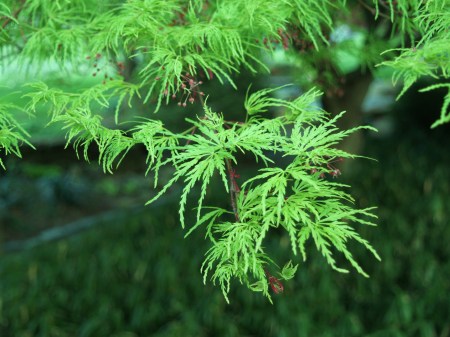
Most of the trees are small, sort of, but some that you’d think to be small are not quite so. Two ‘Seriyu’ Japanese maples were planted close to the house, inside the front walk. More or less, I understood how large these trees grow, and the intention was to eventually walk under the branches. But, when the book says thirty feet, the mind imagines twenty, so the tree grows a bit taller and a lot wider than you expected. So, now you walk down the front path in the splendid filtered shade of the two maples, but the driveway is impassable to anything larger than my wife’s Honda Civic.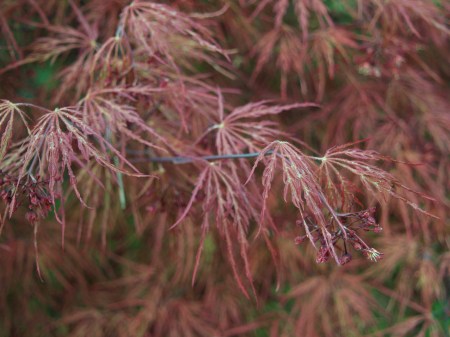
The same thing happened, more or less, to a magnificent ‘Crimson Queen’ Japanese maple planted a bit further up the driveway. This tree was initially planted beside the front walk, but it began to spread too wide so I was forced to transplant it, though transplant is perhaps not the proper term. I began to dig the tree, but grew tired halfway through, so I grabbed a tow strap, circled the roots and attached it to the back of my Miata. The wheels spun for a moment, and then, out it popped. This is a long ways from the proper way to move a tree, but fortunately the maple quickly recovered.
The ‘Crimson Queen’ was fairly large when I planted it, then it grew a bit larger by the walk, and when I moved it to a spot along the driveway I was careful to give it adequate space. But, apparently I wasn’t careful enough. Now, it has grown a foot into the driveway. I suppose my thought process at the time I planted it was, yes, I’ve seen ‘Crimson Queen’ grow to ten feet across, but it won’t get to that until long after I’m dead and gone. Well, I’m still here, and it’s ten feet across and still growing. My wife suggests we either prune the maple or rebuild the driveway on the far side of the house, on the opposite side of the garage. I’m fairly certain she’s being sarcastic, but I’m considering the idea.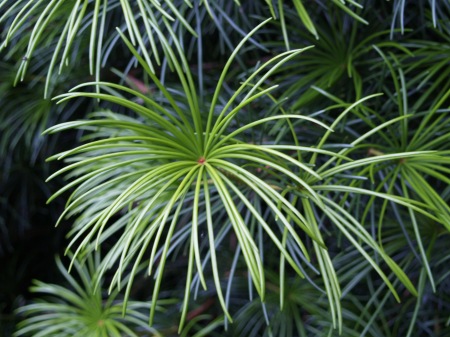
Along the northern boundary of the property a Japanese Umbrella pine melds into a ‘Jane’ magnolia, which is partially overhung by a Golden Rain tree. A sourwood is mostly engulfed by the rain tree and on the other side by the last remaining of three hornbeams, with a huge pink weeping cherry to the low side. The cherry ends where a massive ‘Nellie Stevens’ holly begins, which is then overhung by a massive weeping beech and a fastigiate form of Southern magnolia. Below this are a dogwood, ‘Okame’ cherry, three gold tipped ‘Sekkan Sugi’ cryptomerias, a katsura, then three ‘Yoshino’ cryptomerias. No, we’re not done yet. There’s another Southern magnolia, the cold hardy ‘Bracken’s Brown Beauty, then ‘Hearts of Gold’ yellow leafed redbud, a Paperbark maple, and finally, a river birch.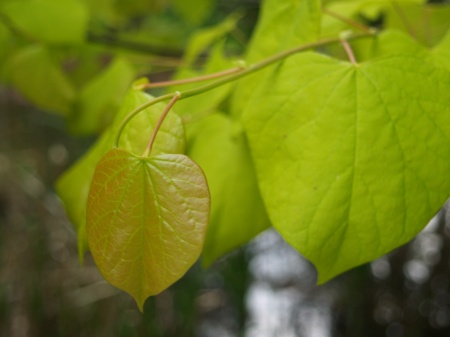
This is the longest stretch of property line, but there’s barely an inch of space that is not under the canopy of one tree or several. All grow in relative harmony, though I wish I had given more space to the weeping beech, which would be quite magnificent if only it could be seen. The neighbor has a grand view of it from his side.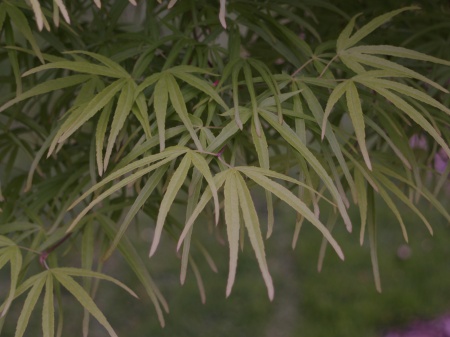
The southern border of the property is wooded by native maples and tulip poplars, with a stray black gum and dogwoods, and a sprinkling of oaks. Between the borders there are plenty of trees, but these are mostly Japanese maples that are smaller and slower types so that the sun actually peaks through in some spots
I’ve been convinced by my wife that there’s no more space for trees in the garden, back or front, but in recent years a few trees have been toppled in severe storms, so I’ve been able to plant a few new ones. And, in late autumn I decided to push into the brush and brambles that bordered the garden at the front corner, so a new area was opened up where a catalpa and sweetbay magnolia were planted. It’s not exactly on my property, but it’s close enough to claim, and all I want to do is plant a few trees on it, not build a house. Before I cut out mulberries, brambles, and a tangle of vines there was little sun in this area, but now it’s opened up a bit. Not for long.
Dave, thank you for making reading about gardening fun! I always get a smile out of your blog entries.
sounds like heaven!
Dave,
Have you noticed the dead/brown tips of the majority of oak trees in the area? I have never noticed this problem before and was hoping you knew what the issue was.
As always, thanks for your help.
I suspect the dead branch tips are caused by the recent invasion of cicadas. They make a slit in pencil sized branches to lay their eggs. The branch tips then die and fall to the ground, and the cicada larvae dig themselves down to the tree’s roots to feed for the next seventeen years.
what is the first photo of? love your blog! the trunk of my fringe tree looks strange to me…
The top photo is of the flowers of serviceberry (Amelanchier canadensis) from earlier in the spring.
If you pay close enough attention, lots of things in the garden look strange, but if you don’t bother with it most everything turns out just fine without any intervention. Only on rare occasion does a plant require any care on my part, and usually the problem wasn’t too evident and it’s lost before I can do anything anyway.